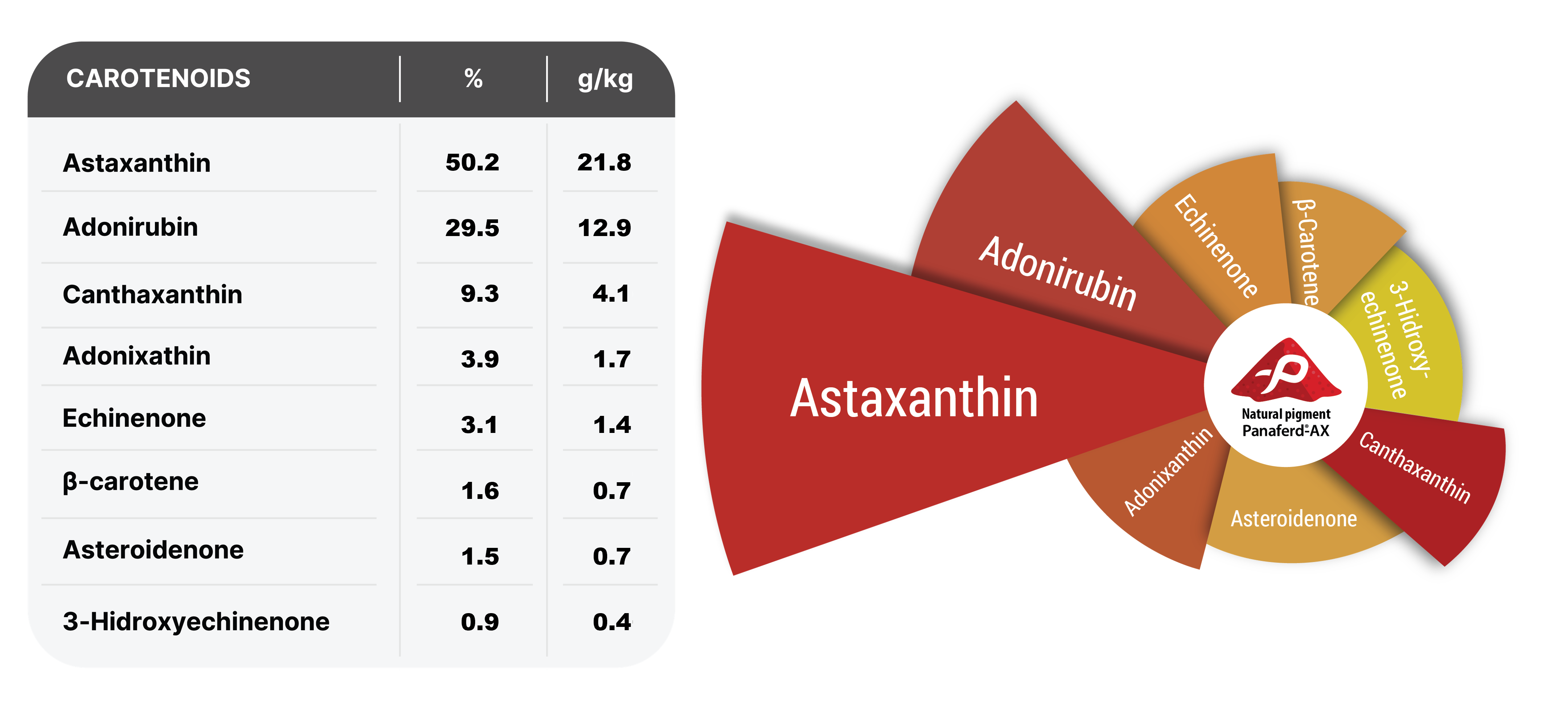Nature’s solution

The natural carotenoids from Panaferd-AX have benefits for RAS farms.
Colour is the symbol of salmon and a good pigmentation is considered as a major quality parameter in the industry. Meanwhile, demands from the markets all over the world lean towards more
products free of any synthetic additives when possible. Natural pigment sources such as Panaferd®-AX have grown significantly over the past 10 years, becoming the standard in the Scottish salmon industry.
Panaferd®-AX is a unique natural source of carotenoids. It contains not only astaxanthin but also other carotenoids (Fig.1).

Figure 1: Carotenoid profile in Panaferd®-AX
For RAS farming, the use of natural pigment also brings several major benefits.
Benefits for image: For consumers, land-based farming may appear full of pipes and complex water filtration system far away from their natural environment and the image of fjords and lochs.
Among positive claims for salmon RAS farms to strengthen their image and re-connect to nature, a key element is the use of sustainable feed, free of synthetic additives such as pigment. A majority of consumers state that the appearance of the fillet is important and that they are willing to pay more for organic salmon than conventional salmon if the fillet colour is similar (Olesen et
al., 2010).
Most premium RAS farms well understand this strategy and benefits. To give a few examples: In Poland, RAS Jurassic Salmon farm feed their salmon with natural pigment, giving an
extra value to their ASC-certified salmon, delivered daily to the Polish and German markets (www.lososjurajski.pl). In Switzerland, Swiss Lachs RAS salmon farm is using Panaferd and delivers, to
customers all over Europe, fresh whole salmon, fillets, steaks or smoked, with a fantastic natural colour (www.swisslachs.ch ). Swiss Lachs has recently confirmed the expansion of its production capacity to supply a growing demand.
Benefits for fish health: in RAS farms, farming conditions might be challenging for fish through high densities and optimal growth conditions year-round. For salmonids, carotenoids have proven numerous effects such as antioxidants and immune health promoters, vitamin A precursors, reproduction and growth enhancers.
A 13-week feeding trial (Kalinovski et al., 2019) was carried out with juvenile rainbow trout to test two diets: a control diet without astaxanthin (CTRL diet), and a diet supplemented with 100 mg/
kg of astaxanthin (ASTA diet). During the last week of the feeding trial, fish were exposed to episodic hyperoxia challenge for eight consecutive hours per day. Episodic hyperoxia induced physiological stress responses expressed by a significant increase in plasma cortisol and hepatic glycogen, with a decrease in plasma glucose levels.
In this study, the decrease of plasma glucose and the increase of hepatic glycogen content due to hyperoxia were significantly emphasized with the ASTA diet. Moreover, hyperoxia decreased most of antioxidant enzyme activities in liver, whereas dietary AX supplementation specifically increased glutathione reductase activity, major antioxidant protective enzymes. Furthermore, the increased muscle AX deposition together with higher TBARS levels recorded after the hyperoxia challenge may suggest a high susceptibility of the muscle tissue to oxidative damage.
Showing an opposite trend to muscle, liver displayed a lower AX content after episodic hyperoxia which could be related to the higher antioxidant enzyme activity in this tissue (Fig 2: Adapted from Kalinowski et al., 2019).

Figure 2: Tissue astaxanthin content comparison in rainbow trout under normoxia (12 weeks) and hyperoxia (1 week) environments. Source adapted from Kalinowski et al., 2019.
Another study (Ytrestoyl, et al., 2021) investigates the effect of astaxanthin on performance and gene expression of seawater-adapted Atlantic salmon, fed diets with a low content of marine ingredients (similar to actual feed formulations) for 84 days. Salmon (initial weight around 200 g) were fed two similar diets, except astaxanthin at below 1 and 48 mg/kg, respectively.
At the end of the trial period, there was no significant effect of astaxanthin on survival, growth rate and final body weight. But transcriptome responses in different organs suggested that no dietary astaxanthin has functional consequences in salmon fed low marine diets. In the intestine of salmon without astaxanthin, decreased expression was observed on several immune genes including genes of innate antiviral immunity. In the liver, the effects of astaxanthin deficiency on lipid metabolism and especially on increased mono-, di- and triacyl glyceride were clearly described, similar to fish fed diets deficient in omega-3 fatty acids.
The greatest transcriptome changes of astaxanthin deficiency were observed in skeletal muscle with an up-regulation of immune-related genes and multiple genes with well-established association with stress. The transcriptome profile suggested mild inflammation, similar by the gene expression profiles in virus infected tissues.
The future of RAS farming is tremendous in many countries. Salmon colour deserves to be natural and Panaferd-AX has a strong, positive claim to add value for farmers and consumers. Furthermore, in the toolbox of functional feeding, carotenoids have confirmed their nutritional benefits at various steps of the production cycle.
Dominique Corlay,
Aquaculture Natural Solutions
For more information on Panaferd-AX, visit Panaferd.com.
All references available upon request.


